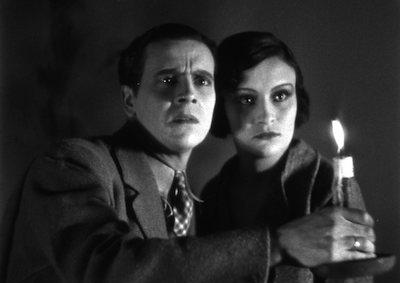Access every screening in the UCLA Festival of Preservation with a $50 pass.
El fantasma del convento (Mexico, 1934)
The Phantom of the Monastery
Restoration funding provided by The Film Foundation's World Cinema Project and The George Lucas Family Foundation.
While the first Mexican horror film, La Llorona (1933), a jumbled telling of the Mexican legend of “The Crying Woman” cross pollinated with “The Cat and the Canary,” precedes it by a year, El fantasma del convento is the first Mexican horror film of true import. On a walking tour, a married couple and their best friend are overtaken by nightfall and seek shelter at an ancient monastery. They are given refuge by the brothers. The abbot tells them that the cloister is haunted by the spirit of a monk who sold his soul to the devil in exchange for his best friend’s wife, a legend that parallels the infidelity in the travelers’ own personal dynamic. Through the night the supernatural gains sway until dawn discloses new revelations.
Fernando de Fuentes, considered the finest director of early Mexican cinema, is best regarded for his three films of the Mexican revolution, El prisionero trece (1933), El compadre Mendoza (1934) and Vámonos con Pancho Villa (1936). El fantasma del convento is a comparative chamber work, steeped in mysticism and Catholic guilt. Its intimate quality shares a sensibility with Carl Dreyer’s Vampyr (1932) and Herk Harvey’s Carnival of Souls (1962), two other independent films that likewise linger along the grey margin of life. Like those films it probes the ephemeral moment when the veil between life and death is rent, when dreams and death prowl the land of the living. Its connectivity to this aesthetic extends to the derelict filming location, Colegio de San Francisco Javier, northeast of Mexico City, a dead space like the Courtempierre flour mill in Vampyr and the Saltair Pavilion in Carnival of Souls. Similarly, it shares a reliance on music that demonstrates the power of the diabolical, here a brief but powerful score by Max Urban.—Scott MacQueen
35mm, b/w, 85 min. Production: Producciones FESA. Distribution: Rayo Films. Director: Fernando de Fuentes. Producer: Jorge Bezet. Screenwriters: Jorge Bezet, Fernando de Fuentes, Juan Bustillo Oro. Cinematographer: Ross Fisher. Cast: Enrique del Campo, Marte Roel, Carlos Villatoro, Paco Martínez, Victorio Blanco.
Restored by UCLA Film & Television Archive in conjunction with The Film Foundation’s World Cinema Project and in collaboration with the Permanencia Voluntaria Film Archive and Filmoteca de la UNAM. Preserved from the 35mm nitrate picture and track negatives and a 16mm acetate composite dupe negative. Laboratory services by Fotokem, Roundabout Entertainment, Inc., Audio Mechanics, DJ Audio, Inc, and Titrafilm Paris. Special thanks to Viviana García Besné, Permanencia Voluntaria; Albino Álvarez Gómez, Filmoteca de la UNAM.






 Mobile Navigation
Mobile Navigation

